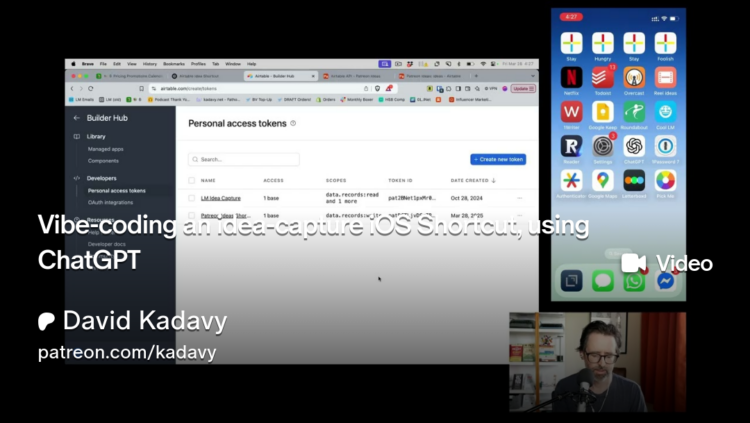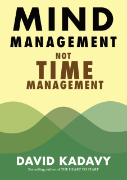Subscribe to blog updates via email »
February 2025 income report
To listen to an audio version of this report, join the Patreon »
February’s revenue was $3,658, down from January’s $5,815. Profits were -$983, down from January’s $2,143.

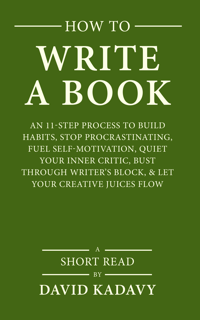
WANT TO WRITE A BOOK?
Download your FREE copy of How to Write a Book »
(for a limited time)
This isn’t the first time I’ve lost money, but it was enough this time I added a “-$1,000” mark to the income graph.
Record-low profit (loss!)
This month’s “profit” is not a typo. I actually lost nearly $1,000 running my business this month, and this after two consecutive months in which I profited barely $2,000.
These days are a far cry from a couple years ago, when I was breaking records (high) every month. Ever since peak 12-month revenue and profit of $118,829 and $72,112, respectively, in January 2023, numbers have been going down.
That shouldn’t be too surprising. It’s been more than four years since I last released a major book (Mind Management). Slightly less if you count the surprise-hit short read, Digital Zettelkasten.
But, I am in a better position than when I launched Mind Management. November 2020, which began just days after the launch of MMT, had my record-low 12-month income, of $63,351. Profits were $36,243, bouncing back from the record low two months prior, of $32,213.
As of this month, my 12-month income is $79,470, which is considerably higher. However, my profits are only $39,677, which isn’t much higher! My 12-month ad spend in November 2020 was a record low of $15,453. For the past twelve months, it’s a middle-of-the-road $24,869.
This isn’t the first time I’ve reported a loss. The one other time was December of 2018, when my profit was -$773. That was the first time I even had a 12-month profit, which was $36,639.
Obviously it sucks to have revenue and profit declining and it sucks big time to lose nearly $1,000, but I long wanted much of what I have now. My 12-month average profit from books is nearly $3,000, at $2,996. In December 2018, it was $550. In November 2020, it was $441.
But, I lost money on books this month: $130. I’ve done that two times before. In October 2019, I lost $180 on books, and in June 2020, I lost $836.
Hard at work to Finish What Matters
I’m in a better position than I was before publishing my last major book, but it’s also been nearly four years since I published my last major book.
I’ve made over $178,000 in revenue, $100,000 of that profit, from Mind Management. While I’ve published smaller books and made other products in the interim, nothing seems to come close to working my ass off on a book for years on end. So far, those have all sold well.
The black swan that’s technically a white swan is Digital Zettelkasten, which was way less work than my typical major book, and has made, I dunno, quite a bit of money.
So, while it’s really putting my amygdala into alarm losing nearly $1,000 in a month, I’m trying to stay calm and keep working hard on Finish What Matters. And, in fact, $500 of the expenses that have put me in this hole were for editing help on that.
After many years of digging deep into finishing creative projects, I’m getting a cohesive enough picture of it I’m pretty confident I can get a compelling book out there.
But, it’s very hard writing. One month in, I’m maybe 75% done with one chapter.
Writing each “magnum opus” is a different challenge from the previous. There are supposedly “swoopers” who write a shitty first draft and edit, and there are “bashers” who polish each sentence as they go. I am writing this one as a basher, at least in this nth iteration of the book. If I get stuck, I just sit there and work it out. I re-read and edit as I go, massaging it so everything flows nicely. Before I had a few books under my belt I was too eager to make sure I finished, but now I have the confidence to bash, whether foolishly or not.
Shifting self-publishing model: “Barbell Wide?”
This dip has me thinking about the shifting self-publishing model. I’ve already done a lot of shifting over the past couple years, growing my direct sales to a larger portion than I had expected. However, the pie those direct sales are a portion of is getting smaller.
I’m beginning to feel like the proper model for me might be “Barbell Wide.” Borrowing the barbell metaphor from the barbell strategy, this would mean to cut out the “middle” of the Wide publishing strategy.
On one end of the barbell, you would have Amazon. On the other end of the barbell, you would have direct sales. In the middle, you would cut out all those other channels that bring in meager income at the cost of administrative burden.
Of the more than $178,000 I’ve made on Mind Management, less than $6,000 of that has come from PublishDrive, which I use to publish ebooks outside of Amazon.
If something is bringing in 4% of your revenue, should you bother with it? Consider also that I’ve made about the same amount selling directly to customers as I have through PublishDrive.
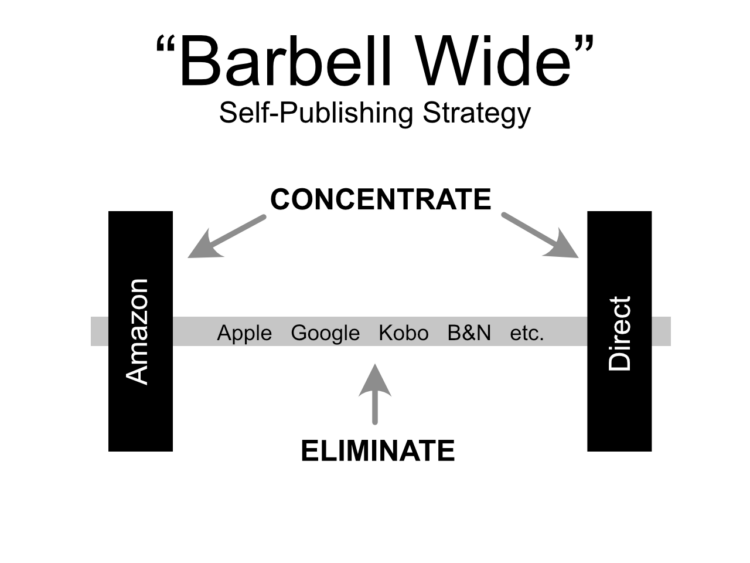
I used to publish ebooks wide to “fight the good fight” and give consumer’s choices. But now that I sell direct, why bother? “Either buy from Amazon or buy from the author,” is still consumer choice. If we’re to speak on moral grounds, it’s the more “virtuous” choice. Apple, Google, and Wal-Mart (Kobo) would be the other choices. Okay, so B&N somehow looks like a mom-and-pop shop in the ebook world.
I suspect that to some degree, the existence of my ebooks on these other platforms cannibalizes my sales on Amazon. Some portion of those sales happening on what would be the middle of the barbell would otherwise be driven to Amazon. Each sale that happens somewhere other than Amazon drives down the book’s sales ranking, which prevents it from being discovered by new readers. My track record after seven years wide on other platforms shows not many sales happen there no matter what. If a sale is going to happen somewhere other than Amazon, it might as well be directly from me.
I also find that my Shopify store has a tough time competing on SEO with the many retailers my books are available on. If a book is only available on Amazon and my own store, my own store at least ranks second. If it’s available on these five retailers, it can rank as low as sixth. In reality, my books are available on many more stores, so my own store is much lower in the search rankings. Also, I’d only be cutting out ebooks on these platforms. I’d still make paperbacks and hardbacks available through IngramSpark. But, maybe the lack of ebook option would make these retailers easier to compete with.
The takeaway is, Maybe Amazon is no longer a revenue center, but actually a customer-acquisition channel. Instead of trying to maximize revenue with my ebooks on Amazon, maybe I’m going back to cheap or even free ebooks, while offering within the book coupons to buy paperbacks from my Shopify store at a discount. I can still charge a decent price for ebooks on my Shopify store, as consumers wise-up to the fact they’re merely “renting” their Kindle books.
The case(s) against Barbell Wide
One contrary opinion is, “Just upload the ebooks to PublishDrive and collect your royalties. How hard is that?” But as a one-person company, the devil is in the details of that statement.
First there’s the uploading. I create two versions of each ebook to upload Amazon and PublishDrive. In one, the “Also by David Kadavy” page links to Amazon, with affiliate links. In the other, it links to a Books2Read page. It would be weird to buy a book on Apple Books and find links to Amazon. Not only do I have to create these two versions, every time I fix errata, I have to do it in both versions. Every time I publish a new book, I have to update the “Also by” page in both versions. Then I have to upload both.
Then there’s reporting. I feel it’s important to generate these detailed income reports, so I’m conscious of how I’m managing my business. I spend probably fifteen minutes per month just collecting and entering the data from PublishDrive into my various reports. That’s three hours a year. I made under $2,000 on PublishDrive in 2024 (compared to more than $30,000 from Amazon KDP and about $7,500 on my Shopify store). If I assumed just collecting this data was the only work involved, I’m making over $600 an hour from PublishDrive, which now that I look at it is kind of compelling. But how much more work is it, actually, and at what opportunity costs?
Finally, there is the harder-to-measure cognitive load. I suspect there are many more ways simplifying my distribution would benefit my business. For example, if I only have Amazon and Shopify, I can focus more of my mental energy on figuring out how to get Amazon customers to buy from my Shopify store, or how to get my first-time Shopify customers to be repeat customers. My calls-to-action in all my marketing materials would be simplified, too. Instead of the current, “Amazon, Direct, and everywhere else (which includes dozens of links),” there would just be “Amazon or Direct.” Consider also that of the two ebook versions I create for uploading to various services, neither is optimized for promoting my direct-sales channel. Making a direct-sales-optimized one would be an easier decision if there were only two channels involved – even more simple, just one that’s only direct-sales-optimized and goes everywhere.
The second contrary opinion, the more valid one, is that going Barbell Wide would probably kill my chances at BookBub Featured Deals. BookBub heavily favors ebooks that are available outside of Amazon, and even if yours is only available on Amazon, you still have to pay the same for a promotion. The other channels have 70% ebook royalties over Amazon’s 35%, so that’s a chunk of how you make up for the expense. Indeed the majority of my wide sales have been driven by BookBub Featured Deals.
This is a huge “con,” but it’s not currently relevant to my books. I have applied for BookBub Featured Deals for MMT and HTS over the past year, and they have been rejected eight times each. MMT came out in 2020. Its days of being chosen for BookBub Featured Deals may be over, or at least spaced out over longer periods. HTS is even older.
I doubt I would want to launch my next book without making it available on all the wide channels, just to make it more appealing for BookBub Featured Deals. But since that next launch is still a bit off, right now might be a golden opportunity to try Barbell Wide.
If I do this, I’ll probably do a six-month trial. Ironically, it could be a bit of work to go Barbell Wide. I’m still thinking of all the implications, but this is one idea that keeps coming back to me.
Meditation challenge: 90 days!
A major reason I’m paying attention to the fact Barbell Wide keeps coming back to me is I’ve now done 90 consecutive days of hour-long meditation sessions.
I started off doing an hour for a few days, grew to consider doing the Naval Ravikant meditation challenge of 60 hours in 60 days, then blew past that goal.
This is the fourth time I’ve done at least 60 days. The first time I went 89 days, purposely quit to avoid getting attached to the streak, then kept going a bit longer.
This time I decided to keep the streak going. I don’t think I’m that attached to it. It’s just that I feel so much better and have so much better a day after an hour of meditation, I don’t want to go a day without it.
I’m considering shooting for 300 hours in 2025. I did an extra two hours one day, and so I have that on top of the 90+ hours in my streak.
As usual, I have much more clarity about what I should or shouldn’t do when I meditate an hour a day. I really consider it a key part of my workday now. When I did my first 89 days was when I decided to write Digital Zettelkasten. It went from being a crazy idea I was considering, to something I couldn’t ignore, to something I did, to one of the best decisions I ever made for my business. Maybe that will be true for Barbell Wide, or some other idea I get during this latest meditation renaissance.
Mind Management price slowing down sales
One culprit for my low revenue has been sales of Mind Management. I averaged over $1,400 in profits per month from MMT throughout 2024, but two months into 2025, I’ve made a total profit of only $318. I had the least sales in February since December 2020, shortly after launching the book. I sold 263 copies in February, and in December 2020 I sold 238.
The main culprit for these low sales is the price has been $9.99 for the longest period since the launch of the book.
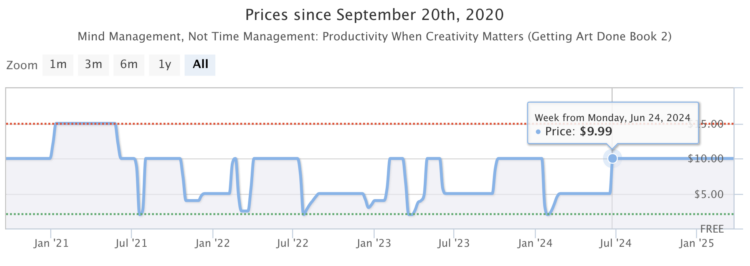
I can see that since about the time I set that price, my sale ranking has dropped, and become more volatile.
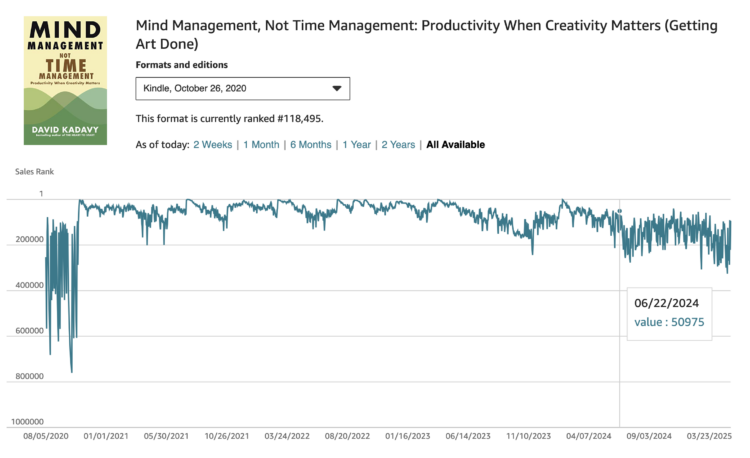
However, something seems to have happened right about the beginning of the year. MMT sales inexplicably fell off a cliff.
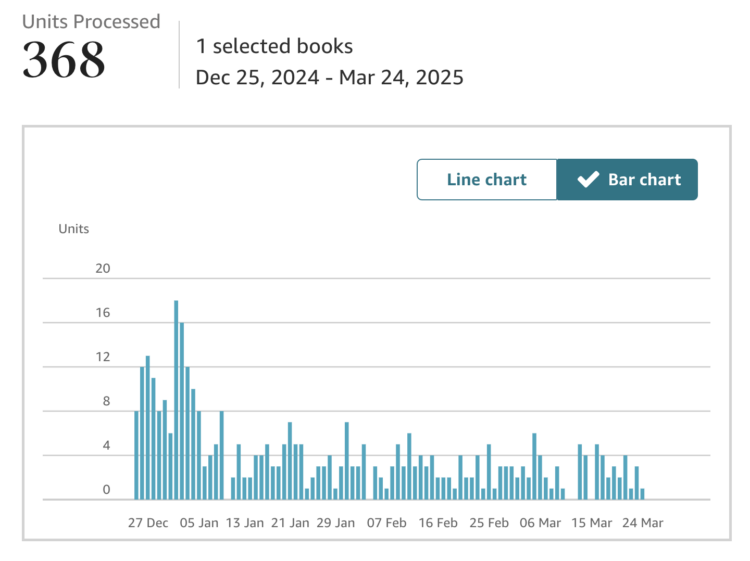
I’ve kept it at that price since June – 9 months – because I’ve been hoping to conjure up a Kindle Deal, or at least get a BookBub Featured Deal.
Unfortunately, I’ve had neither! MMT hasn’t been chosen for a Kindle Deal in the U.S., and despite managing my promotion applications with my special calendar, MMT has been rejected for a BookBub Featured Deal eight times in a row.
I do hope to drop the price and run some kind of promotion soon, but as I think about going Barbell Wide, there are some things I’d like to get in place first. For example, I’d like to include a really strong lead magnet somewhere about after chapter 1, to promote direct sales and make the price drop worthwhile.
I’ve greatly reduced my Amazon ad spend in March, as it doesn’t seem to be effective right now, but I have lined up a couple influencer marketing promotions.
AMA/Livestream complete
I did my first AMA/Livestream in two years a couple days ago. I answered questions mostly about self-publishing, but a bit about creative productivity. In case you missed it, you can watch the replay here.
I unfortunately wasn’t able to answer all the questions in the hour, so if I missed yours, I’m sorry! I will have to do another AMA in sooner than two years!
New on Patreon: Vibe-coding an idea-capture iOS Shortcut
I’ve had a really useful idea-capture Shortcut on my iOS home screen the past several months. You tap it, a box comes up, you type in your idea, and it saves it to the appropriate place.
So I shared how to code one that saves ideas to an Airtable base, using ChatGPT as a guide, in the latest Patreon screencast.
Though I edited for brevity, I stumble a lot in getting this accomplished, which will be a good example for any unexperienced programmers who haven’t yet had the courage to dive into using ChatGPT to code useful tools.
Income
Book Sales
| Mind Management, Not Time Management | $1,034 |
| 100-Word Writing Habit | $174 |
| 100 Journal Prompts Workbook | $112 |
| How to Sell a Book | $88 |
| Digital Zettelkasten | $830 |
| The Heart to Start | $154 |
| How to Write a Book | $70 |
| Total Book Sales | $2,461 |
Misc. Products
| 100-Word Habit Wristband | $22 |
| Total Misc. Products | $22 |
Affiliates / Advertising
| Active Campaign | $372 |
| Alliance of Independent Authors | $143 |
| Amazon | $189 |
| BYOK | $213 |
| Google Adsense | $117 |
| Total Affiliates | $1,035 |
Reader Support
| Patreon | $141 |
| Total Reader Support | $141 |
Services
| Clarity | $0 |
| Medium | $0 |
| Total Services | $0 |
| GROSS INCOME | $3,658 |
Expenses
General
| Accounting | $765 |
| Book Printing | $307 |
| Outside Contractors | $569 |
| Quickbooks | $32 |
| Shipping and Handling | $0 |
| Total General | $1,673 |
Advertising
| Amazon | $1,842 |
| BookBub | $0 |
| $0 | |
| Meta | $449 |
| Influencer Marketing | $300 |
| Product Samples | $0 |
| Total Advertising | $2,591 |
Hosting
| ActiveCampaign | $112 |
| Bookfunnel | $30 |
| Drafts | $2 |
| Dropbox | $10 |
| Fathom Analtyics | $14 |
| Libsyn | $5 |
| Namecheap | $34 |
| Obsidian Publish | $10 |
| SendOwl | $9 |
| Shopify | $39 |
| Ulysses | $3 |
| WP Engine | $96 |
| Zapier | $14 |
| Total Hosting | $378 |
| TOTAL EXPENSES | $4,641 |
| NET PROFIT | -$983 |

